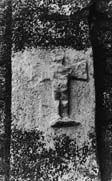Select a site alphabetically from the choices shown in the box below. Alternatively, browse sculptural examples using the Forward/Back buttons.
Chapters for this volume, along with copies of original in-text images, are available here.
Object type: Quoin stone with Crucifixion
Measurements:
Whole stone: L. c. 90 cm (35.4 in) W. c. 30 cm (11.8 in) D. c. 30 cm (11.8 in)
Sculpture: L. c. 35 cm (13.8 in) W. c. 22 cm (8.7 in)
Stone type: [Ancaster Freestone, Upper Lincolnshire Limestone, Inferior Oolite Group]
Plate numbers in printed volume: Ills. 322–4
Corpus volume reference: Vol 5 p. 241-242
(There may be more views or larger images available for this item. Click on the thumbnail image to view.)
On the west face of one of the 'long' stones in this 'long-and-short' quoin is a small crucifix carved in high relief. The carving has been deliberately damaged, presumably in a phase of iconoclasm, so that only the lower parts survive – the upper parts of the crucifix are present only in outline. The shaft and upper arm of the cross are rectangular, with slightly tapering horizontal arms of type B6. Nothing can be said of the upper parts of the figure but the legs are spaced apart, with the feet apparently projecting forwards and standing on a flat suppedaneum at the base of the cross-shaft.
This small damaged crucifix may be a unique case in Anglo-Saxon sculpture of a decorative carving adorning a quoin. The quoin itself is certainly original and should be dated, along with the church nave, to the late tenth or eleventh century (Taylor and Taylor 1965, 522). It is, however, hard to see what function a crucifix might have served in such a position. It might be seen as an early form of consecration cross, but it is placed too high in the quoin to have been used in any consecration ceremony of the type known from the later Middle Ages (e.g. Muncey 1930, 67–76). The difficulty of explaining why the stone is in both an inaccessible and unparalleled position may suggest that the crucifix has been deliberately retained from an earlier use of the stone. If the quoin were constructed from reused sections of an earlier shaft (as are several others locally – at Creeton, North Rauceby etc.), then this Crucifixion carving might have been left intact deliberately when the decoration around it was trimmed off. This would certainly explain why the crucifix is, unusually, in high relief. There is however, no corroborative evidence for this suggestion. No firm dating for the sculpture can be provided as the figure is so damaged, although from the position of the feet it belongs early in the typology of Crucifixion figures and is unlikely to be later than the eleventh century (Coatsworth 1979; 1988).



